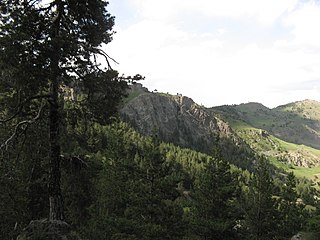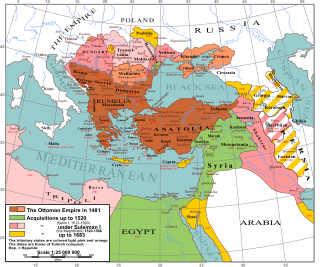
Eyalets, also known as beylerbeyliks or pashaliks, were the primary administrative divisions of the Ottoman Empire.

Ardahan Province is a province in the north-east of Turkey, bordering Georgia and Armenia. Its area is 4,934 km2, and its population is 92,481 (2022). The provincial capital is the city of Ardahan. Ardahan borders the Turkish provinces of Erzurum, Artvin and Kars.

The Eyalet of Sidon was an eyalet of the Ottoman Empire. In the 19th century, the eyalet extended from the border with Egypt to the Bay of Kisrawan, including parts of modern Israel and Lebanon.

Oltu is a municipality and district of Erzurum Province, Turkey. Its area is 1,441 km2, and its population is 30,075 (2022). The mayor is Adem Çelebi, from the AKP.

Khimshiashvili was the name of several Georgian noble families, with their bases in the regions of Kakheti and Adjara. A Kakhetian family was part of the princely nobility of Georgia and, then, of the Russian Empire, while the Adjarian Khimshiashvili were important frontier beys under the Ottoman Empire and wielded noticeable influence in this part of southwestern Caucasus throughout the 19th century. The Russians rendered their family name as Khimshiyev and as Adzharsky, while to the Turks they came to be known as Hamşioğlu.

The House of Jaqeli was a Georgian princely (mtavari) family and a ruling dynasty of the Principality of Samtskhe, an offshoot of the House of Chorchaneli.

The Samtskhe-Saatabago or Samtskhe Atabegate, also called the Principality of Samtskhe, was a Georgian feudal principality in Zemo Kartli, ruled by an atabeg (tutor) of Georgia for nearly three and a half centuries, between 1268 and 1625. Its territory consisted of the modern-day Samtskhe-Javakheti region and the historical region of Tao-Klarjeti.

Lala Mustafa Pasha's Caucasian campaign was a military expedition launched in 1578 by Lala Mustafa Pasha, a grand-vizier of the expanding Ottoman Empire. It is also considered a part of the larger conflict, Ottoman–Safavid War (1578–90).
Dedisimedi was a Georgian noblewoman of the House of Mukhrani, a collateral branch of the royal Bagrationi dynasty. She was princess consort of Samtskhe as wife of Kaikhosro II Jaqeli and regent for her son Qvarqvare IV Jaqeli. She played a leading role in a civil war that plagued Samtskhe from 1576 to 1578. After the Ottoman takeover of her principality, Dedisimedi retired to Kartli, leaving the government to her son, Manuchar II Jaqeli, who continued to rule as an Ottoman pasha.

Kör Yusuf Ziyaüddin Pasha, also known as Yusuf Ziya Pasha, was an Ottoman statesman of Georgian origin, who twice served as the Grand Vizier of the Ottoman Empire in 1798–1805 and 1809–1811. Before, between and after his terms as grand vizier, he served numerous posts as governor of various provinces and districts throughout the empire. As grand vizier, he commanded the Ottoman ground forces against the French Army in the Ottoman reconquest of Egypt and later served as a commander in the Ottoman wars with the Russian Empire.
Manuchar II Jaqeli also known as Mustafa Pasha, of the House of Jaqeli, was prince of Samtskhe and the pasha of its capital Akhaltsikhe from 1581 to 1607. Later, when he was removed from power by the Ottomans, he fled to Safavid Iran, where he served at the Safavid court until his death, and continued to claim the title of atabeg of Samtskhe.
Manuchar III Jaqeli, of the House of Jaqeli, was the last atabeg of the principality of Samtskhe, nominally ruling between 1607 and 1625. As a child, he accompanied his father, Manuchar II Jaqeli, when the latter settled at the Safavid Iranian court, then located at Qazvin. Later, when the Iranian royal court had already been moved to Isfahan, his mother Elene had been making efforts in order for her son to be able to succeed as the next atabeg. She discussed the matter at court with then incumbent Safavid king Abbas I, Alexander II of Kakheti, as well as the Portuguese diplomat Antonio de Gouvea. With Manuchar III living at the court, Elene herself received "virtually nothing" from Abbas I, although she had offered him sovereignty over Samtskhe. Having been confirmed in 1607 as ruler of Samtskhe by Abbas I, Manuchar III continued to fight the Ottomans in a similar fashion to his father. However, he ceased his activities in 1608, when due to the circumstances, he was forced to flee to Kartli. Following his father's death in 1614, Manuchar III now officially claimed the title of atabeg of Samtskhe and made active efforts to incite anti-Ottoman sentiments in the area. Later, in 1624, he battled against the Ottoman pasha of Erzurum; shortly after, he moved to Kartli once again. There, he supported Giorgi Saakadze against the Iranians, and was reputable at the Battle of Marabda. In 1625, he resumed relations with the Ottomans, who subsequently confirmed him as atabeg of Samtskhe; when he actually returned to Samtskhe however, he was killed (poisoned) by his own uncle Beka Jaqeli, better known as Sefer Pasha. Manuchar III was the last Christian ruler of Samtskhe; upon his death in 1625, the Ottomans completely incorporated the western part of the principality of Samtskhe as a pashalik. In 1639, by the Treaty of Zuhab, they also gained the eastern part, which had been under Safavid control. The members of the House of Jaqeli, who had been at the head of the principality for centuries, converted to Islam, and remained in power as hereditary pashas in the Ottoman service.
Mzetchabuk Jaqeli was a Prince and Atabeg of Samtskhe-Saatabago during 1500–1515, member of the Jaqeli family and son of Qvarqvare II Jaqeli. After his older brother's death Mzetchabuk had seized the Atabeg's throne from his nephew, Qvarqvare. He was an ambitious and arrogant ruler. Like his father and grandfather, Mzetchabuk demanded the separation of the Meskhetian church from the Georgian Orthodox church. Atabeg Mzetchabuk Strived to strengthen Samtskhe. He nominally obeyed Ottoman sultan Selim I and with his help Adjara came fully under Meskhetian rule. In 1515 old Mzetchabuk abdicated and became a monk, received a monastic name Jacob. After Mzetchabuk Atabeg's title would be given to his nephew Qvarqvare, but Mzetchabuk's younger brother Manuchar rebelled against him. The war for succession was won by Manuchar and he became the next Atabeg. Mzetchabuk Jaqeli died in 1516, at the age of 70–71.
Manuchar I Jaqeli was a Prince and Atabeg of Samtskhe-Saatabago from 1515 to 1518. He was a member of the Jaqeli family and youngest son of Qvarqvare II Jaqeli. After his older brother Mzetchabuk's abdication Manuchar started an uprising against his nephew Qvarqvare, the son of Kaikhosro I. Manuchar's revolt finished successfully and he ascended to the Meskhetian throne. During his brief reign Manuchar sent many gifts to the Ottoman sultan Selim I and claimed himself as an admirer of Ottomans. In 1518 the new revolt started. Prince Qvarqvare with the help of Safavid troops attacked Samtskhe. Manuchar was overthrown and Qvarqvare became the new ruler of Meskheti. After this Manuchar asked his suzerain Sultan Selim for help. Sultan gave him the huge army. He had tried to restore himself as Atabeg, but was defeated by Qvarqvare's forces at the battle near Erzurum. Manuchar Jaqeli escaped to the Ottoman empire and lived there until his death. Nothing is known about his later life and descendants.
Qvarqvare III Jaqeli (1469–1535) was a Georgian ruling Prince and Atabeg of Samtskhe-Saatabago during 1518–1535. Member of the Jaqeli family and son of Atabeg Kaikhosro I Jaqeli. His failure to capture the throne at the death of his father Kaikhosro may have been caused by the ambition of his uncle Mzetchabuki, who had seized Atabeg's title from him. Despite this Mzetchabuk Jaqeli declared Qvarqare as his successor. During his uncle's reign Qvarqvare actively involved in state affairs. In 1515 ill Mzetchabuk resigned from the throne and came to the Monastery as a monk. Qvarqvare couldn't ascend to the Meskhetian throne, because his second uncle Manuchar I had revolted. Qvarqvare went to Safavid Persia, became vassal of Shah Ismail I and lived at his court in Tabriz until his accession. In 1518 Qvarqvare commanded Qizilbash army and invaded Samtskhe. Persians dethroned Manuchar I and placed Qvarqvare on the throne. Manuchar invited Ottomans to fight against Safavids and overthrow his nephew, but Qvarqvare's forces defeated him at the battle near Erzurum, after which Manuchar escaped to the Ottoman empire. During Qvarqvare's reign Persian influence on Samtskhe was growing day by day. Because of that Turks greatly damaged the country and especially its southwestern region. Meskhetian lords had recognized that under Qvarqvare's rule Samtskhe would finally turn to the Enemy's hands. They made an alliance with the Georgian kings, Bagrat III of Imereti and Luarsab I of Kartli to end up Jaqelian rule and protect Samtskhe from dominant Muslim empires. In 1535 King Bagrat III invaded Samtskhe. He defeated and captured Qvarqvare III at the Battle of Murjakheti near Akhalkalaki, Georgians had annexed Principality of Samtskhe. Qvarqvare died in prison. A few years later, his survived youngest son Kaikhosro II requested Ottomans to expel Imeretian and Kartlian forces from Samtskhe. In 1545, at the Battle of Sokhoista, Kaikhosro defeated Bagrat III, after which he reinstated his legitimate throne. Samtskhe became vassal of the Ottoman empire. Qvarqvare III's descendants ruled Samtskhe-Saatabago and then Childir Eyalet until 1820s.

Qvarqvare IV Jaqeli was a Georgian Prince and Atabeg of Samtskhe-Saatabago, ruling nominally in 1573–1581. He was member of the Jaqeli family and the son of Kaikhosro II Jaqeli. During his nominal reign Meskhetian lords revolted several times against Jaqelian rule. Uprisings were suppressed by Ottomans. In 1578 Ottomans started new war against Safavid Persia for the hole territory of Caucasus. Lala Mustafa Pasha invaded Georgia. Qvarqvare IV obeyed him. Pasha had decided to send Qvarqvare and his younger brother Manuchar to Constantinople for recognizing Ottoman absolute rule in Samtskhe. Qvarqvare left the government to his mother, Dedisimedi and went to the capital of the Ottoman Empire. In 1579 by the order of Sultan Murad III Ottomans divided Samtskhe-Saatabago into eight Sanjaks and established Childir Eyalet on the lands of Meskheti. Qvarqvare IV was appointed as Christian ruler of Childir Eyalet, but his brother Manuchar converted to Islam under the name of Mustafa and became the Ottoman Pasha. Qvarqvare died childless in 1581 and was succeeded by his Muslim brother Manuchar II.
Beka III Jaqeli, also known as Sefer Pasha, was a Georgian ruler of Childir Eyalet and vassal of the Ottoman Empire from 1625 to 1635. He was a member of the Jaqeli family and the third son of Kaikhosro II Jaqeli and Dedisimedi. Beka came to power after poisoning his nephew Manuchar III, the last Christian ruler of Samtskhe-Saatabago. After this Beka III went to Istanbul, on the court of Sultan Murad IV. He converted to Islam, called himself Sefer Pasha and returned to his ruling state. Under his rule Ottomans started the process of spreading Islam in Samtskhe. Sefer Pasha Died in 1635 and was succeeded by his son, Yusuf I as a new Pasha of Childir.
Yusuf I Jaqeli, also known as Yusuf Pasha, was a Georgian ruler of Childir Eyalet and vassal of the Ottoman Empire from 1635 to 1647, member of the Jaqeli family and the son of Beka III Jaqeli, better known as "Sefer Pasha.". In 1635, after his father's death Ottomans guaranteed Jaqeli family the Meskhetian throne, if they convert to Islam. Yusuf with his family and relatives became Muslim and started ruling Childir. He took appearance in the Ottoman-Safavid war. In 1647 Yusuf I died by unknown illness, leaving the throne to his son, Rostom.
The Battle of Karagak was fought between the armies of the Kingdom of Imereti and the Ottoman Empire at the place of Karagak, Meskheti, in 1543.
The Battle of Chkheri took place between the Kingdom of Imereti and the Ottoman Empire during the Russo-Turkish War (1768–1774), on February 6, 1774.










